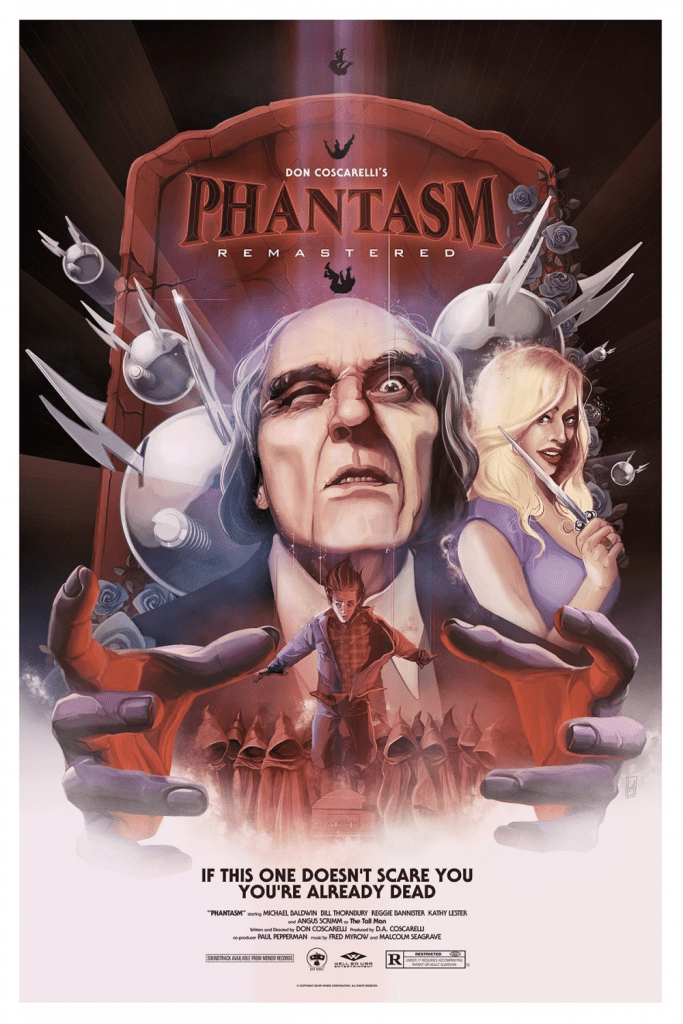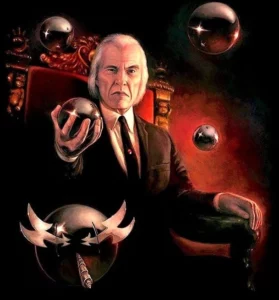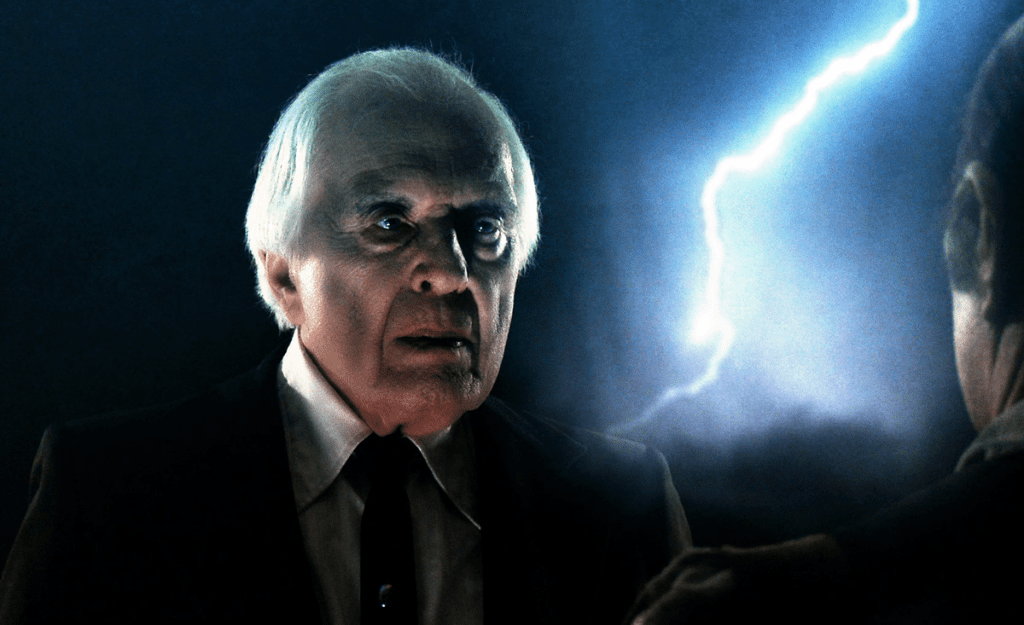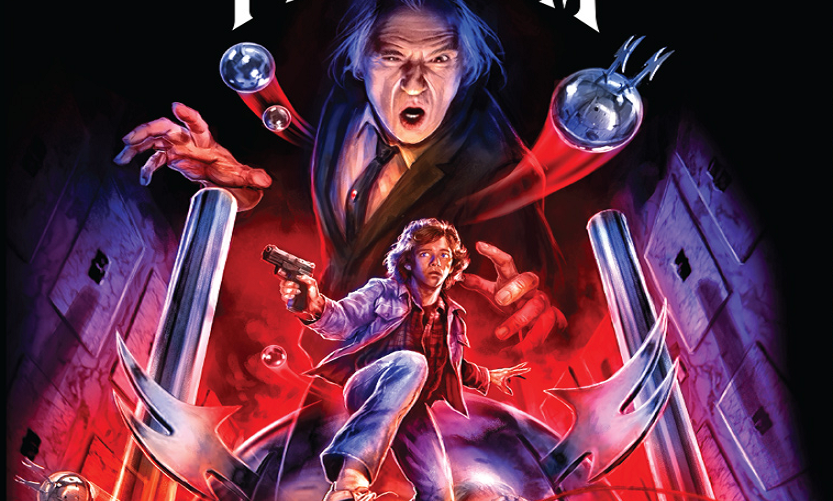When Phantasm premiered in 1979, it was more than just another low-budget horror flick—it was the birth of a cult phenomenon. Written and directed by Don Coscarelli, this indie masterpiece captivated audiences with its surreal atmosphere, iconic characters, and chillingly inventive concepts. From its origins in a secluded cabin to becoming a cornerstone of horror cinema, Phantasm has etched its legacy into the annals of filmmaking. Decades later, its eerie allure remains as powerful as ever.
How Phantasm Was Born: From Dream to Reality
In 1977, Don Coscarelli secluded himself in a remote cabin with a single goal: to create a script unlike anything audiences had ever seen. Drawing inspiration from vivid dreams, existential fears, and a love for the surreal, he crafted the world of Phantasm. The story centered around Mike Pearson, a young boy who discovers the sinister plans of the enigmatic Tall Man—played to perfection by Angus Scrimm—and his otherworldly silver spheres.

Filming began in Southern California with a tight-knit crew and a shoestring budget. Coscarelli collaborated with longtime friends and actors, including Michael Baldwin and Reggie Bannister, to bring his vision to life. Despite financial and logistical challenges, their passion and ingenuity transformed Phantasm into a unique blend of horror, science fiction, and surrealism.
1979: A Low-Budget Film Becomes a Global Sensation
Released in 1979, Phantasm quickly exceeded all expectations. Despite its modest budget of $300,000, the film grossed over $11 million at the box office and enjoyed an unprecedented year-long theatrical run. Audiences were captivated by its dreamlike narrative, haunting soundtrack, and the menacing presence of the Tall Man, whose chilling utterance—“Boy!”—became an iconic catchphrase.
The film’s mix of horror and science fiction set it apart, creating a genre-bending experience that resonated with fans around the world. From the UK and Japan to Germany and France, Phantasm became an international hit, laying the groundwork for its enduring cult status.
The 1980s: Cult Status and the Long-Awaited Sequel
Following its success, fans clamored for more. However, nearly a decade passed before Phantasm II finally hit theaters in 1988. During this gap, the original film gained a second life on home video and cable television, drawing new fans into its eerie universe.
Phantasm II, backed by Universal Pictures, brought a larger budget and expanded the franchise’s mythology. The sequel deepened the story, explored the Tall Man’s dark plans, and reunited beloved characters like Reggie and Mike. Critics praised its ambitious scope and inventive practical effects, while fans celebrated the continuation of a franchise that had captured their imaginations.
The 1990s: Expanding the Franchise with Bold New Ideas
The 1990s saw the release of two more sequels, Phantasm III: Lord of the Dead (1994) and Phantasm: Oblivion (1998). These films leaned further into the franchise’s surreal elements, introducing new characters like Rocky and Tim while expanding the Tall Man’s otherworldly backstory. Although budget constraints limited their scope, these entries retained the unique blend of horror, science fiction, and dark humor that fans had come to love.
During this time, Angus Scrimm’s portrayal of the Tall Man received widespread recognition. In 1994, he was inducted into Fangoria’s Horror Hall of Fame alongside legends like Boris Karloff and Bela Lugosi, solidifying his place in horror history.
A Digital Era Revolution: Engaging Fans Online
In the mid-1990s, Don Coscarelli embraced the burgeoning internet to connect directly with fans. By launching the official Phantasm website in 1995, he provided behind-the-scenes updates, exclusive content, and a platform for fans to engage with the franchise. This innovative approach strengthened the bond between creators and fans, keeping the franchise alive during periods of inactivity.
The 2000s: Revival Attempts and Fan Dedication

The early 2000s saw ambitious attempts to revitalize the franchise. Plans for Phantasm 1999 A.D.—a high-budget sequel featuring Quentin Tarantino and Bruce Campbell—generated excitement but ultimately fell through due to development challenges. Despite this setback, Phantasm continued to thrive on home media, with DVD releases and collector’s editions introducing the series to new audiences.
Fans remained loyal, organizing conventions and screenings to celebrate the franchise. The Tall Man’s haunting world remained a touchstone for horror enthusiasts, ensuring the series’ cultural relevance.
2014-2016: A Triumphant Revival and Farewell

In 2014, fans were thrilled to learn about Phantasm: Ravager, the long-awaited fifth installment. Directed by David Hartman, the film returned to the franchise’s independent roots, with a skeleton crew and a story steeped in nostalgia. Released in 2016, it offered a heartfelt conclusion to the saga while paying tribute to its loyal fanbase.
Around the same time, J.J. Abrams and his production company, Bad Robot, unveiled Phantasm: Remastered. This meticulously restored version of the original film introduced its eerie brilliance to a new generation, earning praise for its enhanced visuals and sound.
Tragically, 2016 also marked the passing of Angus Scrimm, whose portrayal of the Tall Man had become synonymous with the franchise. Phantasm: Ravager served as a fitting farewell, honoring both Scrimm’s legacy and the enduring spirit of the series.
The Legacy of Phantasm: A Touchstone of Horror Cinema
More than four decades after its debut, Phantasm remains a cornerstone of the horror genre. Its influence can be seen in countless films, from its surreal storytelling to its inventive practical effects. The franchise’s ability to evolve while staying true to its roots has kept it relevant across generations.

The series’ iconic imagery, from the deadly silver spheres to the menacing Tall Man, continues to captivate fans. Collectibles like the Sphere Collection and screenings at horror conventions keep the franchise alive, while new viewers discover its eerie allure.
Conclusion: The Spirit of Phantasm Lives On
As the Tall Man ominously declared, “It’s never over.” Phantasm isn’t just a series of films—it’s a testament to the power of independent filmmaking, creative storytelling, and the unbreakable bond between creators and fans. From its humble beginnings in a secluded cabin to its status as a cultural phenomenon, Phantasm has proven that great stories transcend time.
Whether you’re a lifelong “Phan” or a newcomer, the haunting world of Phantasm invites you to dream, fear, and wonder. One thing is certain: the Tall Man’s sh



